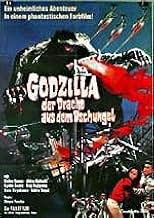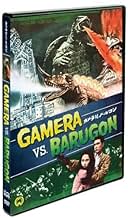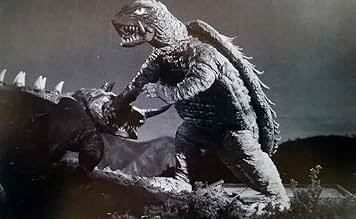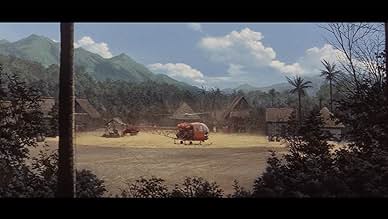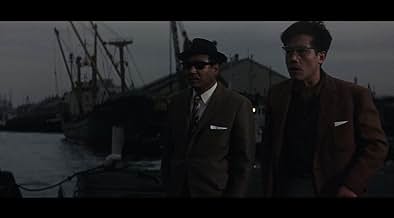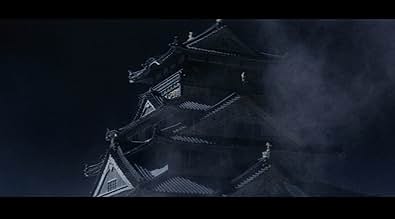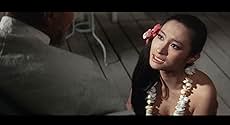VALUTAZIONE IMDb
5,1/10
2948
LA TUA VALUTAZIONE
Aggiungi una trama nella tua linguaA giant monster that emits a destructive ray from its back attacks Japan and takes on Gamera.A giant monster that emits a destructive ray from its back attacks Japan and takes on Gamera.A giant monster that emits a destructive ray from its back attacks Japan and takes on Gamera.
Jutarô Kitashiro
- Self-Defense Force Commander
- (as Jutarô Hôjô)
Trama
Lo sapevi?
- QuizThis is the only film in the original series to not feature a child as the main human character.
- BlooperEnglish language version: If Barugon's is harmed by water, how did he swim from the sunken ship to the shore without any difficulty? The translation neglects to mention that while he's vulnerable to water, it doesn't immediately kill him, just weakens him. It has also been suggested that salt water doesn't harm him as much as fresh water.
- Versioni alternativeThe Japanese version runs a complete 101 minutes. The American International Pictures-TV (A.I.P.-TV) release version, under the title WAR OF THE MONSTERS, was cut down to 88 minutes to fit it's televised playdates. The 14 minutes that were removed were only expository scenes that had the characters discuss how to destroy the monster Barugon.
- ConnessioniFeatured in Il mostro invincibile (1968)
Recensione in evidenza
If you're a fan of Gamera from '90s trilogy, Gamera vs. Barugon may be the original Gamera movie for you.
The movie begins with Gamera's being freed from the rocket he was trapped in at the end of Gamera, the Gigantic Monster and returning to Earth to wreak havoc on a dam. He then disappears for a good 45 minutes while the movie follows a trio of treasure hunters to a tropical island on their quest to retrieve an opal the brother of one of the hunters hid in a cave during the Second World War. Not to give away too much, but the procurement of this opal leads to the emergence of Barugon, in the middle of Japan, who Gamera (eventually) fights in typical Gamera fashion.
Three things immediately stand out about the second entry in the Gamera series:
There are no kids in this movie. As in its predecessor, Gamera is apparently motivated purely by a quest for energy sources.
Gamera is barely in the movie. He opens the movie, returns to fight Barugon, then comes back after another long absence to fight Barugon again. The bulk of the movie deals with the birth of Barugon and the Japanese's attempts to defeat him. (Maybe this was the genesis of the military's conflict in Gamera: The Revenge of Iris over which monster to attack first.)
Finally, the movie is in color, and Daiei seems eager to exploit that fact. The opening titles are played out over shapeless colors, and one of Barugon's weapons is a rainbow beam emanating from his back.
The movie contains some silly moments (most notably the theft of the diamond), but the human conflicts and relationships are played surprisingly straight and adult, at least in comparison to those in a typical Godzilla movie; everyone doesn't necessarily agree on strategy, and it's probably safe to say the two leads don't view each other as siblings. The biggest problem with the movie is its odd pacing, but without a delusional kid and several characters who do virtually nothing running around, Gamera vs. Barugon is a decided improvement over the original.
The movie begins with Gamera's being freed from the rocket he was trapped in at the end of Gamera, the Gigantic Monster and returning to Earth to wreak havoc on a dam. He then disappears for a good 45 minutes while the movie follows a trio of treasure hunters to a tropical island on their quest to retrieve an opal the brother of one of the hunters hid in a cave during the Second World War. Not to give away too much, but the procurement of this opal leads to the emergence of Barugon, in the middle of Japan, who Gamera (eventually) fights in typical Gamera fashion.
Three things immediately stand out about the second entry in the Gamera series:
There are no kids in this movie. As in its predecessor, Gamera is apparently motivated purely by a quest for energy sources.
Gamera is barely in the movie. He opens the movie, returns to fight Barugon, then comes back after another long absence to fight Barugon again. The bulk of the movie deals with the birth of Barugon and the Japanese's attempts to defeat him. (Maybe this was the genesis of the military's conflict in Gamera: The Revenge of Iris over which monster to attack first.)
Finally, the movie is in color, and Daiei seems eager to exploit that fact. The opening titles are played out over shapeless colors, and one of Barugon's weapons is a rainbow beam emanating from his back.
The movie contains some silly moments (most notably the theft of the diamond), but the human conflicts and relationships are played surprisingly straight and adult, at least in comparison to those in a typical Godzilla movie; everyone doesn't necessarily agree on strategy, and it's probably safe to say the two leads don't view each other as siblings. The biggest problem with the movie is its odd pacing, but without a delusional kid and several characters who do virtually nothing running around, Gamera vs. Barugon is a decided improvement over the original.
- DrGlitterhouse
- 4 mar 2011
- Permalink
I più visti
Accedi per valutare e creare un elenco di titoli salvati per ottenere consigli personalizzati
Dettagli
- Tempo di esecuzione1 ora 46 minuti
- Mix di suoni
- Proporzioni
- 2.35 : 1
Contribuisci a questa pagina
Suggerisci una modifica o aggiungi i contenuti mancanti

Divario superiore
By what name was Attenzione! arrivano i mostri (1966) officially released in India in English?
Rispondi
